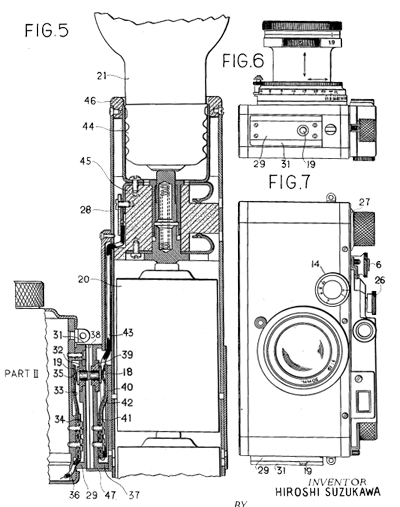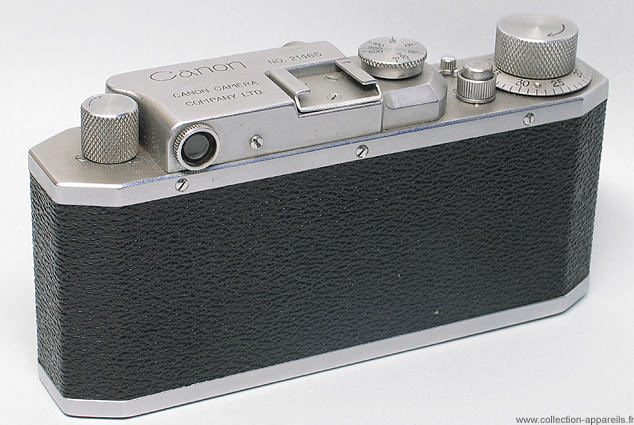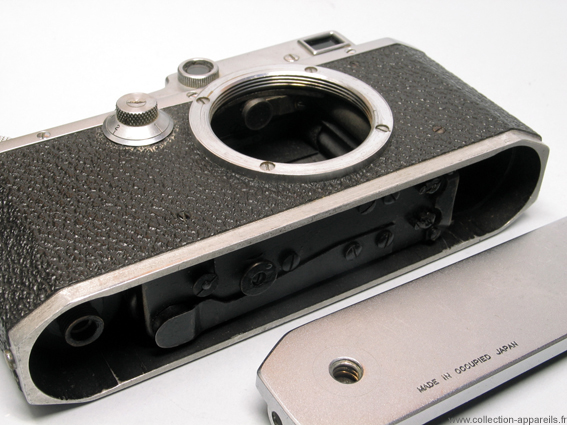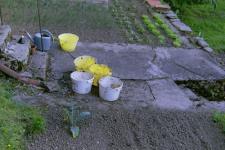|
Canon S II |
Manufactured or assembled in Japan from 1946 to (After) 1946.
Index of rarity in France: Rare (among non-specialized garage sales)
Inventory number: 10521
See the complete technical specifications
Chronology of cameras Canon
The first cameras marketed by Canon were heavily inspired by Leica. Their silhouette remained largely the same until the mid-1950s, with the arrival of the VT. These are 35mm cameras with interchangeable lenses. Some models have a non-standard mount for which only one lens was available. Most of these models are rangefinders. Slow speeds are adjusted using an independent dial located on the front face.
| Name in Europe |
Year | Name for Japan | Name in America |
Shutter | ||
| - | 1936 | Hansa Canon | - | 1/20 to 1/500, B |
approx. 1 100 copies | |
| - | 1939 | J | - | approx. 200 copies No rangefinder |
||
| - | 1939 | NS | - | approx. 100 copies | ||
| - | 1939 | S | - | 1 to 1/500, B |
approx. 1 600 copies | |
| - | 1939 | JS | - | Less than 50 copies No rangefinder |
||
| J II | 1946 | J II | J II | 1/20 to 1/500. B |
approx. 500 copies No rangefinder |
|
| S | 1946 | S I | S | 1 to 1/500, B |
97 copies | |
| S II | 1946 | S II | S II | 7 550 copies | ||
| II B |  |
1949 | II B | II B | 14 400 copies Adding a magnifying glass to the rangefinder. |
|
| II C | 1950 | II C | II C | 1 to 1/500, B. T |
||
| III |  |
1951 | III | III | 1 to 1/1000, B, T |
10 175 copies Replacement of 1/20 with 1/25 |
| IV | 1951 | IV | IV | |||
| III A | 1951 | III A | III A | 9 025 copies Film reminder on the winding knob. |
||
| IV S | 1952 | IV F | IV S | approx. 2 000 copies M sync |
||
| II A | 1952 | - | II A | 1/25 to 1/1000, B | ||
| II D | 1952 | II D | II D | 1 to 1/500, B, T |
21 725 ex No sync. No reminder |
|
| II D' |  |
1952 | II D' | II D' | approx. 2 400 ex No sync, but a reminder |
|
| IV Sb |  |
1952 | IV Sb | IB Sb | 1 to 1/1000, B, T | 34 975 copies X Sync |
| II AF | 1953 | II AF | II AF | 1/25 to 1/500, B |
||
| II AX | 1953 | II AX | II AX | |||
| II F |  |
1953 | - | II F | 1 to 1/500, B, T | 11 900 copies Multi-frame viewfinder |
| II S | 1954 | - | II S | |||
| IV Sb2 |  |
1954 | IV Sb2 | IV Sb2 | 16 800 ex X fast Sync |
|
| II S2 | 1955 | II S2 | II S2 | |||
| - | 1955 | II D2 | II D2 | Replacement of 1/25 with 1/30 | ||
| II F2 | 1955 | - | II F2 | |||
Starting from 1952, some models were synchronized for magnesium flash, and a few years later for electronic flash. The synchronization device is the subject of patent No. US2643597 filed in 1950 (it was filed in Japan in 1948) and the inventor is Hiroshi Suzukawa. The uniqueness lies in the synchronization being done through a rail fixed on the side of the camera.

__________
The Canon S II was produced from October 1946 during the company's name change.
The first units of the S II, also the rarest, bear the engraving of the old company name: SEIKI KOGAKU. Seiki Kogaku Kenku Sho (Precision Optical Research Institute) was founded in November 1933 by two enthusiastic friends: Goro Yoshida, "the inventor," and Saburo Uchida, the businessman. They were soon joined by a few associates, including Takeo Maeda, who held positions as sales director, chief engineer, and design advisor. Maeda, an exceptional individual, played a significant role in the company's success, eventually becoming its President in 1974.
The initial units are equipped with retractable Seiky Kogaku Serenar lenses: a 1.5/50 mm, a 2/50 mm, and a 3.5/50 mm coupled with a rangefinder, and two non-retractable lenses, a 4/13.5 cm, and a 4/20 cm, uncoupled. Some of the very first S II models were equipped with retractable Nikon 5 cm lenses.
The company was renamed CANON CAMERA COMPANY Ltd on August 15, 1947. "Canon" was then engraved on the camera bodies and lenses, which became the famous Canon Serenar lenses. Manufacturing techniques were improved, and the quality of both cameras and lenses became impeccable. The durability, precision, and technical innovations of this Canon family were quickly recognized, leading to immense commercial success.
The S II is the first mass-produced Canon. Compared to its predecessors, it is revolutionary as the first Japanese camera to offer a combined and coupled rangefinder viewfinder. In its Canon version, it is the first to have a standardized mount with a rangefinder measurement roller. It is offered with standard lenses with rangefinder cams.
The total number of S II units produced is 7,550, of which approximately 70% are Canon versions. The serial numbers range from 15,000 to approximately 18,000 for Seiky Kogaku models and from 15,700 to 23,375 for Canon models. The majority of interchangeable lenses (Canon version) are in the 39mm Leica screw mount and coupled to the rangefinder.
Production of the S II ends in June 1949, with a few very small likely re-fabrications in 1950 and even 1952. These productions often involve hybridization (S II Hybrid). Similar to Leica and our national Foca, many units were later modified by the addition of a flash sync socket.



Interesting links or bibliography :
Add a link or element of bibliography, a picture taken with this camera, a picture of box or an ads about this camera
Your photos taken with the same camera:
Cameras from Ebay France (Canon) (Uploaded each 3 hours)




































